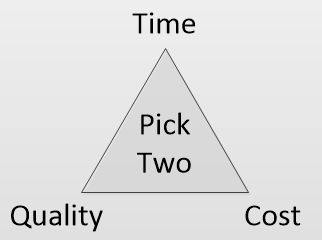There is a popular saying within the project management community:
Time, Cost, Quality, Pick Two.
It means two factors can be controlled if the third can be left uncontrolled, or in other words, you can’t have it all. Of course, this is a simplistic view of a potentially complex set of activities, but it is pragmatic and generally found to hold true. However, where does Risk enter in the equation?
First, what is risk? As risk in a project increases, so does the likelihood of the following:
- Expectations will be viewed as optimistic and unrealistic in hindsight.
- The project will exceed schedule and cost forecasts.
- Product quality and customer approval will be lower than anticipated.
- Production costs will be greater than anticipated.
Risk is primarily a function of complexity and time. Make the project more complex without increasing the time available and the risk of failure increases exponentially. Constrain the time available without reducing scope and the risk of failure increases exponentially. Get the idea? It’s really more of a guideline than a rule though.
When time is not the limiting factor, there will be enough time to figure it out, whatever it is. When there isn’t enough time, decisions will understandably be made based on missing and incorrect information (i.e. speculation), which can result in more work later to correct a bad decision. Additional schedule delays and cost overruns increase project stress, which increases risk, and if left uncorrected may result in the project’s collapse.
Developing a new product is an inherently risky activity, although achieving high-risk goals generally brings greater rewards – otherwise there would be no incentive to accept the risk. However, even if risk cannot be avoided it can be mitigated. Don’t accept unreasonable risk in your projects, and consider moving any very-high-risk tasks into a precursor research project to set appropriate expectations. Also ensure significant risks are well understood by project stakeholders. In a well managed and transparent project there can be no blame, and stakeholders share the consequences of the constraints they set and the risks that were accepted.
There is no place for wishful thinking in project management, and always have a Plan B ready at hand should an activity not execute as expected.
Cheers,
Dale


One Reply to “Time, Complexity, and Cost – but where is Risk?”